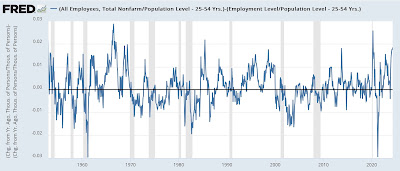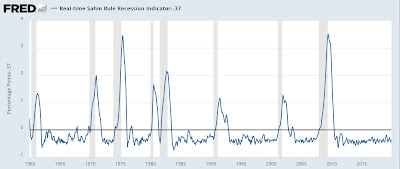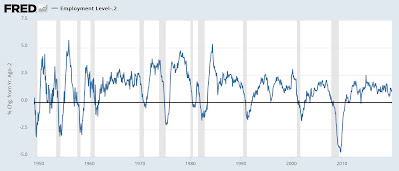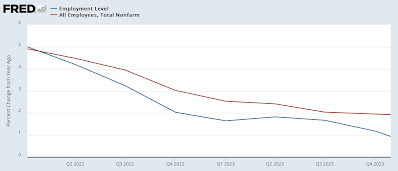– by New Deal democrat As per usual, the Monday after jobs report Friday does not update any significant data. So let me return to the deep divergence between the Household and Establishment Surveys in the jobs report. With Friday’s data for May, the two have now diverged 1.9% over the past year, adjusted for the size of the prime working age population: This big a divergence has only happened previously twice in the 1960s, and one month each during the pandemic and the 1980s. There is clearly a big issue going on. Either the data in one or both series is simply wrong, or the implications of the data in one or both series is incorrect. I spent a fair amount of time during the weekend poking around all sorts of data, and I think I can shed
Topics:
NewDealdemocrat considers the following as important: Hot Topics, Household Survey, June 2014, US EConomics
This could be interesting, too:
NewDealdemocrat writes JOLTS revisions from Yesterday’s Report
Joel Eissenberg writes No Invading Allies Act
Bill Haskell writes The North American Automobile Industry Waits for Trump and the Gov. to Act
Bill Haskell writes Families Struggle Paying for Child Care While Working
– by New Deal democrat
As per usual, the Monday after jobs report Friday does not update any significant data.
So let me return to the deep divergence between the Household and Establishment Surveys in the jobs report. With Friday’s data for May, the two have now diverged 1.9% over the past year, adjusted for the size of the prime working age population:
This big a divergence has only happened previously twice in the 1960s, and one month each during the pandemic and the 1980s. There is clearly a big issue going on. Either the data in one or both series is simply wrong, or the implications of the data in one or both series is incorrect. I spent a fair amount of time during the weekend poking around all sorts of data, and I think I can shed some light on that, but it will take much more than one post.
Let me just begin by restating that the Household Survey for May was simply recessionary. The “real time” Sahm Rule as of May is at .37. The below graph subtracts that amount and shows the entire historical record before the pandemic:
The only times this reading has not meant recession was twice in the 1960s, once in the 1970s, and for several months in 2003.
I’ll spare you the additional graphs, but the same is apparent with the YoY changes in the unemployment and underemployment rates.
And total employment is only up 0.2% YoY. Here’s what a historical graph of that looks like pre-pandemic:
With the exception of two solitary months in 2003 and 2013, there has never been a time since the 1960s when such a paltry YoY increase has not meant recession.
But the Household and Establishment Surveys are not the only official data of employment. The Quarterly Census of Employment and Wages (QCEW) is a comprehensive accounting of the same, covering over 95% of all businesses. It’s one big drawback is that there is no seasonal adjustment, so we have to look at it YoY. It also lags badly, so the most recent update is for Q4 of last year, and further, all of last year’s data is still preliminary and subject to revision.
Nevertheless, let’s compare that with the YoY% changes in employment in the two jobs surveys, through the end of last year:
At the end of Q4 2022, the Establishment Survey showed gains of 3.0% YoY. By the end of 2023, that had declined to 2.0%. Meanwhile, over the same period the YoY gains in the Household Survey had declined from 2.0% to 1.2%.
Although FRED doesn’t have graphs for the QCEW, here are the YoY% gains shown in that Census as of the end of each quarter from Q4 2022 through Q4 2023:
2.8%, 2.5%, 2.5%, 1.7%, 1.5%
Through the end of Q2, the QCEW is in good agreement with the updated Establishment Survey. But in Q3 and Q4, there is a subtantial (as, 0.3% and 0.5%) variance, suggesting that upcoming benchmark revisions to the Establishment Survey will reduce those levels by about 700,000.
For 2024, we can’t rely on the QCEW. But we do have the comprehensive daily update of all withholding taxes paid to the government. The one caution here is that such taxes are paid on things like the vesting of stock options, and not just wages. This is important, because a huge amount of stock options vested and were cashed in at the end of 2022.
With that caveat, here is what the 1 month and 3 month moving average of the YoY% change in withholding taxes paid look like beginning last December through the end of May:
DEC 23. -11.2%. -0.8%
JAN 24. +5.7%. -0.8%
FEB 24. +8.3%. +0.1%
MAR 24. +2.2%. +5.3%
APR 24. +17.1%. +9.0%
MAY 24. +2.5%. +6.7%
The monthly totals are somewhat volatile, as you can see. But once we smooth the data out over three months, and once the December 2022 stock options drop out of the picture, all of the comparisons are positive.
The bottom line is that neither of our two comprehensive comparative data – the QCEW and withholding taxes paid – look recessionary at all. In other words, while the unrevised Establishment Survey readings might be too high, the Household Survey readings on the change in employment look much too low.
But is there reason to believe that the Sahm rule might not be flashing recessionary warnings after all? More on that in another post.
The Bonddad Blog
We have a serious problem: the two job surveys show two completely opposed economies, Angry Bear, by New Deal democrat.




